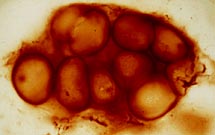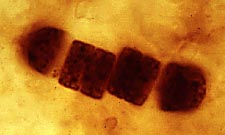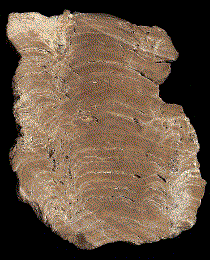







The cyanobacteria have an extensive fossil record. The oldest known fossils, in fact, are cyanobacteria from Archaean rocks of western Australia, dated 3.5 billion years old. This may be somewhat surprising, since the oldest rocks are only a little older: 3.8 billion years old!
Cyanobacteria are among the easiest microfossils to recognize. Morphologies in the group have remained much the same for billions of years, and they may leave chemical fossils behind as well, in the form of breakdown products from pigments. Small fossilized cyanobacteria have been extracted from Precambrian rock, and studied through the use of SEM and TEM (scanning and transmission electron microscopy).


Ancient Fossil Bacteria : Pictured above are two kinds cyanobacteria from the Bitter Springs chert of central Australia, a site dating to the Late Proterozoic, about 850 million years old. On the left is a colonial chroococcalean form, and on the right is the filamentous Palaeolyngbya.
Many Proterozoic oil deposits are attributed to the activity of cyanobacteria, such as Gloeocapsomorpha. Small concentrically layered structures called pisolites are also the result of fossilized bacteria. Cyanobacteria are otherwise rarely preserved in rocks other than chert, though some possible blue-green bacteria have been recovered from shale.
 At right is a layered stromatolite, produced by the activity of
ancient cyanobacteria. The layers were produced as calcium
carbonate precipitated over the growing mat of bacterial filaments;
photosynthesis in the bacteria depleted carbon dioxide in the surrounding
water, initiating the precipitation. The minerals, along with grains
of sediment precipitating from the water, were then trapped within the
sticky layer of mucilage that surrounds the bacterial colonies, which then
continued to grow upwards through the sediment to form a new layer. As
this process occured over and over again, the layers of sediment were created.
This process still occurs today;
Shark Bay in western Australia is well
known for the stromatolite "turfs" rising along its beaches.
At right is a layered stromatolite, produced by the activity of
ancient cyanobacteria. The layers were produced as calcium
carbonate precipitated over the growing mat of bacterial filaments;
photosynthesis in the bacteria depleted carbon dioxide in the surrounding
water, initiating the precipitation. The minerals, along with grains
of sediment precipitating from the water, were then trapped within the
sticky layer of mucilage that surrounds the bacterial colonies, which then
continued to grow upwards through the sediment to form a new layer. As
this process occured over and over again, the layers of sediment were created.
This process still occurs today;
Shark Bay in western Australia is well
known for the stromatolite "turfs" rising along its beaches.
In some cases, the stromatolites were infiltrated with a mineral-rich solution which fossilized the bacteria along with the layers, but more often only the layers are preserved.
The oldest stromatolites date to the Early Archaean, and they became abundant by the end of the Archaean. In the Proterozoic, stromatolites were widespread on earth, and were ecologically important as the first reefs. By the close of the Proterozoic, the abundance of stromatolites decreased markedly, though cyanobacteria continued to leave a fossil record, such as Langiella and Kidstoniella known from the Lower Devonian Rhynie chert.
The cyanobacteria have also been tremendously important in shaping the course of evolution and ecological change throughout earth's history. The oxygen atmosphere that we depend on was generated by numerous cyanobacteria photosynthesizing during the Archaean and Proterozoic Era. Before that time, the atmosphere had a very different chemistry, unsuitable for life as we know it today.
Bitter Springs chert fossil image provided by J. William Schopf. Image of stromatolites provided by the University of Wisconsin Botanical Images Collection.


